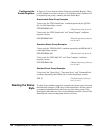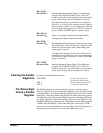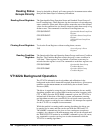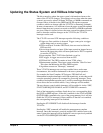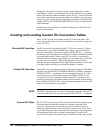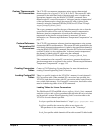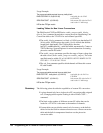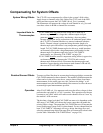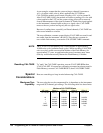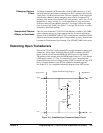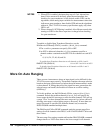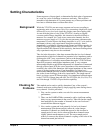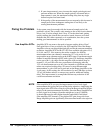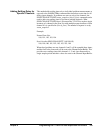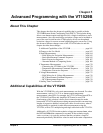
154 Programming the VT1422A for Data Acquisition and Control Chapter 4
As an example, assume that the system wiring to channel 0 generates a
+0.1 volt offset with 0 volts (a short) applied at the UUT. Before
CAL:TARE the module would return a reading of 0.1 volt for channel 0.
After CAL:TARE (@100), the module will return a reading of 0 volts with
a short applied at the UUT and the system wiring offset will be removed
from all measurements of the signal to channel 0. Think of the signal applied
to the instrument’s channel input as the gross signal value. CAL:TARE
removes the tare portion leaving only the net signal value.
Because of settling times, especially on filtered channels, CAL:TARE can
take several minutes to execute.
The tare calibration constants created during CAL:TARE are stored in and
are usable from the instrument’s RAM. To store the tare constants in
non-volatile flash memory, execute the CAL:STORE TARE command.
NOTE The VT1422A’s Flash Memory has a finite lifetime of approximately
10,000 write cycles (unlimited read cycles). While executing CAL:STOR
once every day would not exceed the lifetime of the Flash Memory for
approximately 27 years, an application that stored constants many times
each day would unnecessarily shorten the Flash Memory’s lifetime.
Resetting CAL:TARE To "undo" the CAL:TARE operation, execute CAL:TARE:RESet then
*CAL?/CAL:SET. If current tare calibration constants have been stored in
Flash Memory, execute CAL:TARE:RESET, then CAL:STORE TARE.
Special
Considerations
Here are some things to keep in mind when using CAL:TARE.
Maximum Tare
Capability
The tare value that can be compensated for is dependent on the instrument
range and SCP channel gain settings. The following table lists these limits.
Maximum CAL:TARE Offsets
A/D range
±V F.Scale
Offset V
Gain x1
Offset V
Gain x8
Offset V
Gain x16
Offset V
Gain x64
16 3.2213 0.40104 0.20009 0.04970
4 0.82101 0.10101 0.05007 0.01220
1 0.23061 0.02721 0.01317 0.00297
0.25 0.07581 0.00786 0.00349 0.00055
0.0625 0.03792 0.00312 0.00112 n/a



